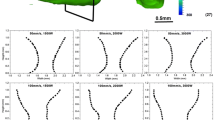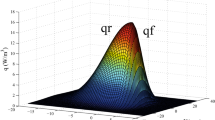Abstract
Weld simulation methods have often employed mathematical functions to describe the size and shape of the molten pool of material transiently present in a weld. However, while these functions can sometimes accurately capture the fusion boundary for certain welding parameters in certain materials, they do not necessarily offer a robust methodology for the more intricate weld pool shapes that can be produced in materials with a very low thermal conductivity, such as the titanium alloy Ti-6Al-4V. Cross-sections of steady-state welds can be observed which contain a dramatic narrowing of the pool width at roughly half way in to the depth of the plate of material, and a significant widening again at the base. These effects on the weld pool are likely to do with beam focusing height. However, the resultant intricacy of the pool means that standard formulaic methods to capture the shape may prove relatively unsuccessful. Given how critical the accuracy of pool shape is in determining the mechanical response to the heating, an alternative method is presented. By entering weld pool width measurements for a series of depths in a Cartesian co-ordinate system using FE weld simulation software Sysweld, a more representative weld pool size and shape can be predicted, compared to the standard double ellipsoid method. Results have demonstrated that significant variations in the mid-depth thermal profile are observed between the two, even though the same values for top and bottom pool-widths are entered. Finally, once the benefits of the Cartesian co-ordinate method are demonstrated, the robustness of this approach to predict a variety of weld pool shapes has been demonstrated upon a series of nine weld simulations, where the two key process parameters (welding laser power and travel speed) are explored over a design space ranging from 1.5 to 3 kW and 50 to 200 mm/s. Results suggest that for the faster travel speeds, the more detailed Cartesian co-ordinate method is better, whereas for slower welds, the traditional double ellipsoid function captures the fusion boundary as successfully as the Cartesian method, and in faster computation times.










Similar content being viewed by others
References
J.C. Williams and E.A. Starke: Acta Mater, 2003, 51 pp. 5775–99.
J.A. Hamill, Jr. and P. Wirth: SAE Technical paper 940355, SAE International Congress, Detroit, 1994.
Y. Shimokusu, S. Fukumoto, M. Nayama, T. Ishide, and S. Tsubota: Mitsubishi Heavy Industries, Ltd. Technical Review, 2001, vol. 38, p. 1.
D. Iordachescu, M. Blasco, R. Lopez, A. Cuesta, M. Iordachescu, and J.L. Ocaña: Proceedings of International Conference on Optimization of the Robots and Manipulators (OPTIROB), 2011.
Q. Wang, D.L. Sun, Y. Na, Y. Zhou, X.L. Han, and J. Wang, Procedia Engineering, 10, (2011) pp37-41.
R. Turner, J. Gebelin, R.M. Ward, J. Huang, and R.C. Reed: Proceedings of 8th International Trends in Welding research Conference, Chicago, 2012.
H.J. Stone, S.M. Roberts and R.C. Reed, Met Trans A, Vol. 31A (2000), pp2261-73.
L.E. Lindgren, Comput. Methods Appl. Mech. Engrg, Vol. 195, 48-49 (2006) pp6710-6736.
V.D. Fachinotti, A. Anca and A. Cardona, Commun. Numer. Meth. Engng, Vol. 27 (2011) pp595-607.
D. Pont and T. Guichard: Computational Mechanics ’95, Springer, Berlin, 1995, pp. 248–53.
O. Grong: Metallurgical Modelling of Welding, The Institute of Materials, Cambridge, 1997.
A. Lundback: Licentiate Thesis, Lulea University of Technology, 2003.
J. Goldak, A. Chakravarti and M. Bibby, Met Trans B, Vol. 15B (1984), pp. 299-305.
R. Prakash and R. Gangradey, Fusion engineering and Design, 88, 9-10, (2013) pp2581-2584.
J.J. Xu, P. Gilles, Y.G. Duan, and C. Yu: Int. J. Press. Vessels Pip., 2012, 99, pp. 51-60.
S.K. Bate, R. Charles and A. Warren, Int. J. Pressure Vessels and Piping, 86, (2009) pp73-78.
JMatPro Materials properties software: Sente Software Ltd, Surrey Technology Centre, Guildford, UK, 2015.
Acknowledgements
This work has been conducted as a part of the CASiM2 collaborative project, between the University of Birmingham, the MTC and Rolls-Royce plc. The authors wish to acknowledge the financial support provided by the ERDF toward this project. Additionally, the authors wish to thank technical staff at software company ESI Group, manufacturers of Sysweld, for the technical support they have provided. Additional thanks to Sente software, manufacturers of JMatPro, for advice and materials data.
Author information
Authors and Affiliations
Corresponding author
Additional information
Manuscript submitted September 28, 2015.
Rights and permissions
About this article
Cite this article
Turner, R.P., Villa, M., Sovani, Y. et al. An Improved Method of Capturing the Surface Boundary of a Ti-6Al-4V Fusion Weld Bead for Finite Element Modeling. Metall Mater Trans B 47, 485–494 (2016). https://doi.org/10.1007/s11663-015-0489-5
Published:
Issue Date:
DOI: https://doi.org/10.1007/s11663-015-0489-5




